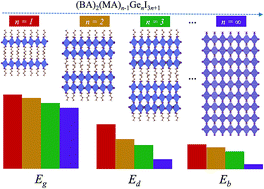First-principles characterization of two-dimensional (CH3(CH2)3NH3)2(CH3NH3)n−1GenI3n+1 perovskite†
Abstract
Two-dimensional (2D) organic–inorganic hybrid perovskites have drawn significant interest due to their great tunability of optoelectronic properties via a control of layer dimensionality and high stability compared to their 3D counterparts. Here, we report structural, electronic, excitonic, and optical properties of lead-free 2D Ruddlesden–Popper hybrid perovskites (CH3(CH2)3NH3)2(CH3NH3)n−1GenI3n+1 (n = 1, 2, and 3) from first-principles calculations. Our results show that the 2D perovskites have a higher stability than their 3D analogous (CH3NH3)GeI3 (n = ∞), and their band gaps decrease with increasing n values, from 1.88 eV (n = 1), to 1.83 eV (n = 2), to 1.69 eV (n = 3), and to 1.57 eV (n = ∞). The 2D perovskites exhibit a strong anisotropic feature, i.e., a low charge carrier effective mass and strong absorption in their 2D planes as compared to that in their third direction. These 2D perovskites also show a high exciton binding energy, allowing for an enhanced photoluminescence quantum efficiency with respect to their 3D compounds. These results suggest a great potential of these germanium-based 2D hybrid perovskites in the optoelectronic applications.

- This article is part of the themed collection: International Year of the Periodic Table : From Pb and Sn Perovskites to the Next Generation


 Please wait while we load your content...
Please wait while we load your content...
